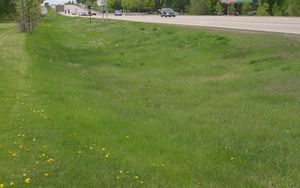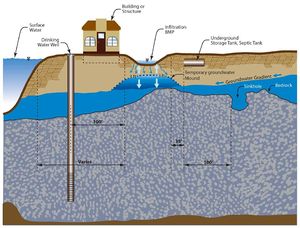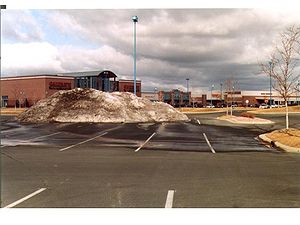
Difference between revisions of "Overview for dry swale (grass swale)"
m |
|||
| Line 90: | Line 90: | ||
{{:Median pollutant removal percentages for BMPs}} | {{:Median pollutant removal percentages for BMPs}} | ||
| − | |||
==Limitations== | ==Limitations== | ||
The following general limitations should be recognized when considering installation of dry swales without underdrains (infiltration). | The following general limitations should be recognized when considering installation of dry swales without underdrains (infiltration). | ||
Revision as of 17:07, 13 June 2022
Dry swales, sometimes called grass swales, are similar to bioretention cells but are configured as shallow, linear channels. Dry swales function primarily as a conveyance BMP, but provide treatment of stormwater runoff, particularly when used in tandem with check dams that temporarily retain water in a series of cells. Dry swales with an underdrain and engineered soil media are considered a filtration. Dry swales with in-situ soils capable of infiltration, (A or B soils) are considered infiltration practices. Dry swales are designed to prevent standing water. Dry swales typically have vegetative cover such as turf or native perennial grasses.
Contents
Function within stormwater treatment train
Dry swales may be located throughout the treatment train, including the main form of conveyance between or out of BMPs, at the end of the treatment train, or designed as offline configurations where the Water Quality Volume is diverted to the filtration or infiltration practice. In any case, the practice may be applied as part of a stormwater management system to achieve one or more of the following objectives:
- reduce stormwater pollutants (filtration or infiltration practices)
- increase groundwater recharge (infiltration practices)
- decrease runoff peak flow rates (filtration or infiltration practices)
- decrease the volume of stormwater runoff (infiltration practices)
- preserve baseflow in streams (infiltration practices)
- reduce thermal impacts of runoff (filtration or infiltration practices)
Typical applications
Applications of dry swales with or without underdrains can vary extensively. Typical applications include
- individual lots for rooftop, driveway, and other on-lot impervious surface;
- shared facilities in common areas for individual lots;
- areas within loop roads or cul-de-sacs;
- landscaped parking lot islands;
- within right-of-ways along roads;
- common landscaped areas in apartment complexes or other multifamily housing designs;
- between buildings in industrial and commercial developments; and
- conveyance between detention structures and receiving waters.
Infeasibility criteria
Certain site-specific conditions may make use of dry swales without underdrains infeasible. Examples include sites where
- infiltrating water would threaten drinking water sources (e.g., in Karst areas);
- ordinances established by the local government with jurisdiction, such as setbacks from structures, conflict with the proposed location;
- infiltrating water would threaten existing below grade basements;
- in situ soil infiltration capacity is too low or too high;
- high levels of contaminants in soil or groundwater exist;
- the only area available for siting does not allow for a safe overflow pathway to the municipal separate storm sewer system or private storm sewer system; or
- reasonable concerns about erosion, slope failure, or down gradient flooding exist and cannot be overcome by swale design modifications.
MPCA permit applicability
One of the goals of this Manual is to facilitate understanding of and compliance with the MPCA Construction General Permit (CGP), which includes design and performance standards for permanent stormwater management systems. These standards must be applied in all projects in which at least 1 acre of land is disturbed and1 acre of new impervious area is being created, and the permit stipulates certain standards for various categories of stormwater management practices.
For regulatory purposes, dry swales fall under the Infiltration / Filtration category described in the MPCA CGP. If used in combination with other practices, credit for combined stormwater treatment can be given. Due to the statewide prevalence of the MPCA permit, design guidance in this section is presented with the assumption that the permit does apply. Although it is expected that in many cases the dry swale will be used in combination with other practices, standards are described for the case in which it is a stand-alone practice.
The following terms are thus used in the text to distinguish various levels of dry swale (grass swale) design guidance:
- REQUIRED: Indicates design standards stipulated by the MPCA CGP (or other consistently applicable regulations).
- HIGHLY RECOMMENDED: Indicates design guidance that is extremely beneficial or necessary for proper functioning of the dry swale, but not specifically required by the MPCA CGP.
- RECOMMENDED: Indicates design guidance that is helpful for dry swale performance but not critical to the design.
There are situations, particularly retrofit projects, in which a dry swale is constructed without being subject to the conditions of the MPCA permit. While compliance with the permit is not required in these cases, the standards it establishes can provide valuable design guidance to the user. It is important to note that additional and potentially more stringent design requirements may apply for a particular dry swale, depending on where it is situated both jurisdictionally and within the surrounding landscape.
Retrofit suitability
The use of dry swales as a retrofit practice primarily depends on existing infrastructure and the compatibility of existing storm drain inverts that need to connect to the dry swale outflow. In general, four to six feet of elevation above the existing collection system invert is needed for dry swale retrofits (2 to 3 feet is needed for perimeter filters).
Special receiving waters suitability
The following table provides guidance regarding the use of dry swales in areas upstream of special receiving waters.
Infiltration and filtration bmp1 design restrictions for special waters and watersheds. See also Sensitive waters and other receiving waters.
Link to this table
| BMP Group | receiving water | ||||
|---|---|---|---|---|---|
| A Lakes | B Trout Waters | C Drinking Water2 | D Wetlands | E Impaired Waters | |
| Infiltration | RECOMMENDED | RECOMMENDED | NOT RECOMMENDED if potential stormwater pollution sources evident | RECOMMENDED | RECOMMENDED unless target TMDL pollutant is a soluble nutrient or chloride |
| Filtration | Some variations NOT RECOMMENDED due to poor phosphorus removal, combined with other treatments | RECOMMENDED | RECOMMENDED | ACCEPTABLE | RECOMMENDED for non-nutrient impairments |
1Filtration practices include green roofs, bmps with an underdrain, or other practices that do not infiltrate water and rely primarily on filtration for treatment.
2 Applies to groundwater drinking water source areas only; use the lakes category to define BMP design restrictions for surface water drinking supplies
Cold climate suitability
Dry swales should remain effective water quality improvement systems for many years, even during winter conditions, if designed and constructed properly. It has been shown that hydraulic efficiency and infiltration rates can remain at levels used for design sizing. However, in cold climates, some special considerations are HIGHLY RECOMMENDED for surface systems like dry swales to ensure sustained functionality and limit the damage freezing temperatures and snow and ice removal may cause. One concern with dry swales used for filtration in cold weather is the ice that forms both over the top of the facility and within the soil interstices. To avoid these problems to the extent possible, it is HIGHLY RECOMMENDED that the facility be actively managed to keep it dry before it freezes in the late fall. This can be done by various methods, including limiting inflow and ensuring the underdrain is functional.
Even if the infiltration properties of a dry swale are marginal for snowmelt runoff during the period of deep frost in the winter, the storage available in the facility will provide water quality benefit if the facility is dry entering the melt season. However, flow originating in an industrial area, a high traffic area where large amounts of salt are added, or another potential stormwater hotspots (PSHs) should be diverted away from dry swales if pretreatment features have not been properly designed to handle such an increase in loading.
For all BMPs it is HIGHLY RECOMMENDED that snow and ice removal plans, including predetermined locations for stockpiling, be determined prior to or during the design process. Dry swales cannot be used for significant snow storage areas as debris build-up, plant damage, and lower infiltration rates are likely to occur. Some snow storage is unavoidable when BMPs are adjacent to areas where snow removal is required. It is critical that the property owner and snow and ice removal contractor have identified other areas for large scale snow storage.
Excessive deicing agents have the potential could lead to reduced soil infiltration rates (from excess sodium) or concentrations that exceed surface water or groundwater standards (from excess chloride). Locations such as busy intersections on slopes, parking garage ramps, or walkways near the entrances of commercial buildings are likely to be heavily treated with deicing agents. This should be taken into consideration when siting any dry swale.
Plant selection is critical to ensure that the damaging effects of snow and ice removal do not severely impact plantings or seedings. Even a small amount of snow storage can break and uproot plants requiring additional maintenance in the spring. Woody trees and shrubs should be selected that can tolerate some salt spray from plowing operations.
For more information on cold climate effects, see Cold climate impact on runoff management.
Water quantity treatment
Where a project’s ultimate development replaces vegetation and/or other pervious surfaces with one (1) or more acres of cumulative impervious surface, the Permittee(s) must design the project so that the water quality volume (Vwq) of one (1) inch of runoff from the new impervious surfaces created by the project is retained on site (i.e. infiltration or other volume reduction practices) and not discharged to a surface water. If the water quality volume cannot be retained due to site constraints, a portion of the water quality volume should be retained on site to the extent that site conditions allow.
The amount of stormwater volume infiltrated depends on the design variant selected. Smaller swales should either be designed offline using a flow diversion, or designed to safely pass large storm flows while still protecting the infiltration area or filtration media. In limited cases (e.g. extremely permeable soils), these dry swales can accommodate the channel protection volume, Vcp, in either an off- or online configuration.
In general, supplemental stormwater practices (e.g. detention ponds) will be necessary to satisfy channel and flood protection requirements when dry swales are used. However, these practices can help reduce detention requirements for a site through volume reduction.
Water quality treatment
Dry swales can remove a wide variety of stormwater pollutants through chemical and bacterial degradation, sorption, and filtering. Surface water load reductions are also realized by virtue of the reduction in runoff volume. Properly designed infiltration systems discussed later in this section will accommodate a design volume based on the required water quality volume. Excess water must be by-passed and diverted to another BMP so that the design infiltration occurs within 48 hours. In no case should the by-passed volume be included in the pollutant removal calculation. No pollutant removal occurs for runoff water that bypasses the practice.
For more information, see Calculating credits for dry swale (grass swale)
Median pollutant removal percentages for several stormwater BMPs. Sources. More detailed information and ranges of values can be found in other locations in this manual, as indicated in the table. NSD - not sufficient data. NOTE: Some filtration bmps, such as biofiltration, provide some infiltration. The values for filtration practices in this table are for filtered water.
Link to this table
| Practice | TSS | TP | PP | DP | TN | Metals1 | Bacteria | Hydrocarbons |
|---|---|---|---|---|---|---|---|---|
| Infiltration2 | 3 | 3 | 3 | 3 | 3 | 3 | 3 | 3 |
| Biofiltration and Tree trench/tree box with underdrain | 80 | link to table | link to table | link to table | 50 | 35 | 95 | 80 |
| Sand filter | 85 | 50 | 85 | 0 | 35 | 80 | 50 | 80 |
| Iron enhanced sand filter | 85 | 65 or 746 | 85 | 40 or 606 | 35 | 80 | 50 | 80 |
| Dry swale (no check dams) | 68 | link to table | link to table | link to table | 35 | 80 | 0 | 80 |
| Wet swale (no check dams) | 35 | 0 | 0 | 0 | 15 | 35 | 35 | NSD |
| Constructed wet ponds4, 5 | 84 | 50 or 685 | 84 | 8 or 485 | 30 | 60 | 70 | 80 |
| Constructed wetlands | 73 | 38 | 69 | 0 | 30 | 60 | 70 | 80 |
| Permeable pavement (with underdrain) | 74 | 41 | 74 | 0 | NSD | NSD | NSD | NSD |
| Green roofs | 85 | 0 | 0 | 0 | NSD | NSD | NSD | NSD |
| Vegetated (grass) filter | 68 | 0 | 0 | 0 | NSD | NSD | NSD | NSD |
| Harvest and reuse | Removal is 100% for captured water that is infiltrated. For water captured and routed to another practice, use the removal values for that practice. | |||||||
TSS=Total suspended solids, TP=Total phosphorus, PP=Particulate phosphorus, DP=Dissolved phosphorus, TN=Total nitrogen
1Data for metals is based on the average of data for zinc and copper
2BMPs designed to infiltrate stormwater runoff, such as infiltration basin/trench, bioinfiltration, permeable pavement with no underdrain, tree trenches with no underdrain, and BMPs with raised underdrains.
3Pollutant removal is 100 percent for the volume infiltrated, 0 for water bypassing the BMP. For filtered water, see values for other BMPs in the table.
4Dry ponds do not receive credit for volume or pollutant removal
5Removal is for Design Level 2. If an iron-enhanced pond bench is included, an additional 40 percent credit is given for dissolved phosphorus. Use the lower values if no iron bench exists and the higher value if an iron bench exists.
6Lower values are for Tier 1 design. Higher values are for Tier 2 design.
Limitations
The following general limitations should be recognized when considering installation of dry swales without underdrains (infiltration).
- Limited monitoring data are available and field longevity is not well documented.
- Failure can occur due to improper siting, design, construction and maintenance.
- Systems are susceptible to clogging by sediment and organic debris.
- When used as an infiltration practice, there is a risk of groundwater contamination depending on subsurface conditions, land use and aquifer susceptibility.
- They are not ideal for stormwater runoff from land uses or activities with the potential for high sediment or pollutant loads.
- They are not recommended for areas with steep slopes. Use step pools for these situations.
- Swales are difficult to protect from sediment-laden runoff during construction.
The following general limitations should be recognized when considering installation of dry swales with underdrains (filtration):
- Limited monitoring data are available and field longevity is not well documented.
- Failure can occur due to improper siting, design, construction and maintenance.
- Systems are susceptible to clogging by sediment and organic debris.
- They are not ideal for stormwater runoff from land uses or activities with the potential for high sediment or pollutant loads.
- They are not recommended for areas with steep slopes.
- Nitrification of water in dry swale media filters may occur where aerobic conditions exist.
- They offer limited or no water quantity control.
- The potential to create odors exists.
Related pages
- Terminology for swales (grass channels)
- Overview for dry swale (grass swale)
- Types of infiltration
- Types of filtration
- Design criteria for dry swale (grass swale)
- Construction specifications for dry swale (grass swale)
- Operation and maintenance of dry swale (grass swale)
- Assessing the performance of dry swale (grass swale)
- Calculating credits for dry swale (grass swale)
- Cost considerations for dry swale (grass swale)
- Case studies for dry swale (grass swale)
- Plants for swales
- Check dams for stormwater swales
- External resources for dry swale (grass swale)
- References for dry swale (grass swale)
- Requirements, recommendations and information for using dry swale (grass swale) without an underdrain in the MIDS calculator
- Requirements, recommendations and information for using dry swale (grass swale) with an underdrain in the MIDS calculator
- Requirements, recommendations and information for using swale side slope as a BMP in the MIDS calculator
- Dry swale (grass swale) and interesting websites



